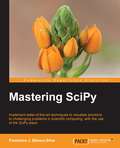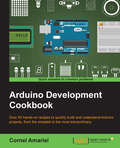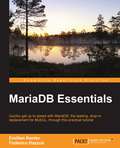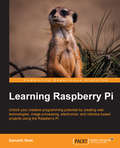- Table View
- List View
Mastering jQuery
by Alex LibbyIf you are a developer who is already familiar with using jQuery and wants to push your skill set further, then this book is for you. The book assumes an intermediate knowledge level of jQuery, JavaScript, HTML5, and CSS.
FuelPHP Application Development Blueprints
by Sebastien DrouyerThis book is for intermediary to seasoned web developers who want to learn how to use the FuelPHP framework and build complex projects using it. You should be familiar with PHP, HTML, CSS, and JavaScript, but no prior knowledge about MVC frameworks is required.
Drupal 8 Configuration Management
by Stefan Borchert Anja SchirwinskiDrupal 8 Configuration Management is intended for people who use Drupal 8 to build websites, whether you are a hobbyist using Drupal for the first time, a long-time Drupal site builder, or a professional web developer.
Learning pandas
by Michael HeydtIf you are a Python programmer who wants to get started with performing data analysis using pandas and Python, this is the book for you. Some experience with statistical analysis would be helpful but is not mandatory.
Mastering pandas for Finance
by Michael HeydtIf you are interested in quantitative finance, financial modeling, and trading, or simply want to learn how Python and pandas can be applied to finance, then this book is ideal for you. Some knowledge of Python and pandas is assumed. Interest in financial concepts is helpful, but no prior knowledge is expected.
QGIS Python Programming Cookbook
by Joel LawheadIf you are a geospatial analyst who wants to learn more about automating everyday GIS tasks or a programmer who is responsible for building GIS applications,this book is for you. The short, reusable recipes make concepts easy to understand. You can build larger applications that are easy to maintain when they are put together.
Elasticsearch Blueprints
by Vineeth MohanIf you are a data enthusiast and would like to explore and specialize on search technologies based on Elasticsearch, this is the right book for you. A compelling case-to-case mapping of features and implementation of Elasticsearch to solve many real-world use cases makes this book the right choice to start and specialize on Elasticsearch.
Blender 3D Cookbook
by Enrico ValenzaThis book is aimed at the professionals that already have good 3D CGI experience with commercial packages and have now decided to try the open source Blender and want to experiment with something more complex than the average tutorials on the web. However, it's also aimed at the intermediate Blender users who simply want to go some steps further. It's taken for granted that you already know how to move inside the Blender interface, that you already have 3D modeling knowledge, and also that of basic 3D modeling and rendering concepts, for example, edge-loops, n-gons, or samples. In any case, it's also possible for a keen beginner to follow this book, by combining it with the manual on the BlenderWiki or preceding it with a basic Blender UI tutorial on the web. The keyboard/mouse shortcuts for the operations in the recipes are, at least in all the more relevant cases, indicated in brackets.
Orchestrating Docker
by Shrikrishna HollaIf you are a competent developer or DevOps with a good understanding of Linux filesystems but want to manage and orchestrate Docker services, images, and products using a multitude of techniques, then this book is for you. No prior knowledge of Docker or container virtualization is required.
Mastering SciPy
by Francisco J. Blanco-SilvaImplement state-of-the-art techniques to visualize solutions to challenging problems in scientific computing, with the use of the SciPy stack About This Book • Master the theory and algorithms behind numerical recipes and how they can be applied to real-world problems • Learn to combine the most appropriate built-in functions from the SciPy stack by understanding the connection between the sources of your problem, volume of data, or computer architecture • A comprehensive coverage of all the mathematical techniques needed to solve the presented topics, with a discussion of the relevant algorithms built in the SciPy stack Who This Book Is For If you are a mathematician, engineer, or computer scientist with a proficiency in Python and familiarity with IPython, this is the book for you. Some basic knowledge of numerical methods in scientific computing would be helpful. What You Will Learn • Master relevant algorithms used in symbolic or numerical mathematics to address approximation, interpolation, differentiation, integration, root-finding, and optimization of scalar or multi-variate functions • Develop different algorithms and strategies to efficiently store and manipulate large matrices of data, in particular to solve systems of linear equations, or compute their eigenvalues/eigenvectors • Understand how to model physical problems with systems of differential equations and distinguish the factors that dictate the strategies to solve them • Perform statistical analysis, hypothesis test design and resolution, or data mining at a higher level, and apply them to real-life problems in the field of data analysis • Gain insights on the power of distances, Delaunay triangulations and Voronoi diagrams for Computational Geometry, and apply them to various engineering problems • Familiarize yourself with different techniques in signal/image processing, including filtering audio, images, or video to extract information, features, or remove components In Detail The SciPy stack is a collection of open source libraries of the powerful scripting language Python, together with its interactive shells. This environment offers a cutting-edge platform for numerical computation, programming, visualization and publishing, and is used by some of the world's leading mathematicians, scientists, and engineers. It works on any operating system that supports Python and is very easy to install, and completely free of charge! It can effectively transform into a data-processing and system-prototyping environment, directly rivalling MATLAB and Octave. This book goes beyond a mere description of the different built-in functions coded in the libraries from the SciPy stack. It presents you with a solid mathematical and computational background to help you identify the right tools for each problem in scientific computing and visualization. You will gain an insight into the best practices with numerical methods depending on the amount or type of data, properties of the mathematical tools employed, or computer architecture, among other factors. The book kicks off with a concise exploration of the basics of numerical linear algebra and graph theory for the treatment of problems that handle large data sets or matrices. In the subsequent chapters, you will delve into the depths of algorithms in symbolic algebra and numerical analysis to address modeling/simulation of various real-world problems with functions (through interpolation, approximation, or creation of systems of differential equations), and extract their representing features (zeros, extrema, integration or differentiation). Lastly, you will move on to advanced concepts of data analysis, image/signal processing, and computational geometry. Style and approach Packed with real-world examples, this book explores the mathematical techniques needed to solve the presented topics, and focuses on the algorithms built in the SciPy stack.
Learning RabbitMQ
by Martin ToshevBuild and optimize efficient messaging applications with ease About This Book • Learn to administer, configure, and manage RabbitMQ instances • Discover ways to secure and troubleshoot RabbitMQ instances • This book is fully up-to-date with all the latest changes to version 3.5 Who This Book Is For If you are a developer or system administrator with a basic knowledge of messaging who wants to learn RabbitMQ, or if you want to further enhance your knowledge in working with the message broker, then this book is ideal for you. To fully understand some examples in the book, a basic knowledge of the Java programming language is required. What You Will Learn • Apply messaging patterns using the message broker • Administer RabbitMQ using the command line, management Web console, or management REST services • Create a cluster of scalable, and highly-available, RabbitMQ instances • Use RabbitMQ with the Spring Framework, MuleESB, WSO2, and Oracle databases • Deploy RabbitMQ using Puppet, Vagrant, or Docker • Fine-tune the performance of RabbitMQ • Monitor RabbitMQ using Nagios, Munin, or Monit • Secure, troubleshoot, and extend RabbitMQ In Detail RabbitMQ is Open Source Message Queuing software based on the Advanced Message Queue Protocol Standard written in the Erlang Language. RabbitMQ is an ideal candidate for large-scale projects ranging from e-commerce and finance to Big Data and social networking because of its ease of use and high performance. Managing RabbitMQ in such a dynamic environment can be a challenging task that requires a good understanding not only of how to work properly with the message broker but also of its best practices and pitfalls. Learning RabbitMQ starts with a concise description of messaging solutions and patterns, then moves on to concrete practical scenarios for publishing and subscribing to the broker along with basic administration. This knowledge is further expanded by exploring how to establish clustering and high availability at the level of the message broker and how to integrate RabbitMQ with a number of technologies such as Spring, and enterprise service bus solutions such as MuleESB and WSO2. We will look at advanced topics such as performance tuning, secure messaging, and the internals of RabbitMQ. Finally we will work through case-studies so that we can see RabbitMQ in action and, if something goes wrong, we'll learn to resolve it in the Troubleshooting section. Style and approach Each chapter of the book is an easy-to-follow guide that expands and builds on the knowledge already gained in previous chapters. Throughout the course of the book, a sample system called the CSN (Corporate Social Network) is used to illustrate the core principles described. At the end of each chapter, there is a Q&A session that covers practical questions that may arise in practice when working with RabbitMQ.
Mastering Machine Learning with R
by Cory LesmeisterMaster machine learning techniques with R to deliver insights for complex projects About This Book • Get to grips with the application of Machine Learning methods using an extensive set of R packages • Understand the benefits and potential pitfalls of using machine learning methods • Implement the numerous powerful features offered by R with this comprehensive guide to building an independent R-based ML system Who This Book Is For If you want to learn how to use R's machine learning capabilities to solve complex business problems, then this book is for you. Some experience with R and a working knowledge of basic statistical or machine learning will prove helpful. What You Will Learn • Gain deep insights to learn the applications of machine learning tools to the industry • Manipulate data in R efficiently to prepare it for analysis • Master the skill of recognizing techniques for effective visualization of data • Understand why and how to create test and training data sets for analysis • Familiarize yourself with fundamental learning methods such as linear and logistic regression • Comprehend advanced learning methods such as support vector machines • Realize why and how to apply unsupervised learning methods In Detail Machine learning is a field of Artificial Intelligence to build systems that learn from data. Given the growing prominence of R—a cross-platform, zero-cost statistical programming environment—there has never been a better time to start applying machine learning to your data. The book starts with introduction to Cross-Industry Standard Process for Data Mining. It takes you through Multivariate Regression in detail. Moving on, you will also address Classification and Regression trees. You will learn a couple of “Unsupervised techniques”. Finally, the book will walk you through text analysis and time series. The book will deliver practical and real-world solutions to problems and variety of tasks such as complex recommendation systems. By the end of this book, you will gain expertise in performing R machine learning and will be able to build complex ML projects using R and its packages. Style and approach This is a book explains complicated concepts with easy to follow theory and real-world, practical applications. It demonstrates the power of R and machine learning extensively while highlighting the constraints.
Getting Started with Knockout.js for .NET Developers
by Andrey AkinshinThis book is intended for .NET developers who want to use the MVVM design pattern to create powerful client-side JavaScript linked to server-side C# logic. Basic experience with ASP.NET, Razor, and creating web applications is needed.
Mastering Play Framework for Scala
by Shiti SaxenaThis book is intended for those developers who are keen to master the internal workings of Play Framework to effectively build and deploy web-related apps.
Mockito for Spring
by Sujoy AcharyaIf you are an application developer with some experience in software testing and want to learn more about testing frameworks, then this technology and book is for you. Mockito for Spring will be perfect as your next step towards becoming a competent software tester with Spring and Mockito.
Learning WebRTC
by Dan RisticIf you are a web developer who wants to create well designed WebRTC applications for your users, this is the book for you. Even if you are early in your web development career, this book aims to provide a complete understanding of the WebRTC API. It is assumed that you have previous exposure to web development using HTML5 and JavaScript technologies.
AngularJS Deployment Essentials
by Zachariah MorenoIf you are a web developer, this handy guide will empower you to quickly learn the fundamentals of AngularJS development and deployment.
Java EE 7 Development with NetBeans 8
by David R. HeffelfingerThe book is aimed at Java developers who wish to develop Java EE applications while taking advantage of NetBeans functionality to automate repetitive tasks. Familiarity with NetBeans or Java EE is not assumed.
Learning Flask Framework
by Matt Copperwaite Charles LeiferBuild dynamic, data-driven websites and modern web applications with Flask About This Book • Discover the most popular Flask resources on the web with ease • Familiarize yourself with third-party libraries commonly used with Flask • Create a fast, interactive, and secure web app with this hands-on guide Who This Book Is For This book is for anyone who wants to develop their knowledge of Python into something that can be used on the web. Flask follows the Python design principles and can be easily understood by anyone who knows Python, and even by those who do not. What You Will Learn • Create your web pages to add modularity and flexibility to your web app using templates • Store and retrieve relational data using SQLAlchemy • Develop schema migrations with Alembic • Produce an admin section using flask-admin • Build RESTful APIs using Flask-Restless • Simulate requests and sessions using the Flask test client • Make Ajax requests from Jinja2 templates In Detail Flask is a small and powerful web development framework for Python. It does not presume or force a developer to use a particular tool or library. Flask supports extensions that can add application features as if they were implemented in Flask itself. Flask's main task is to build web applications quickly and with less code. With its lightweight and efficient web development framework, Flask combines rapid development and clean, simple design. This book will take you through the basics of learning how to apply your knowledge of Python to the web. Starting with the creation of a “Hello world” Flask app, you will be introduced to the most common Flask APIs and Flask's interactive debugger. You will learn how to store and retrieve blog posts from a relational database using an ORM and also to map URLs to views. Furthermore, you will walk through template blocks, inheritance, file uploads, and static assets. You will learn to authenticate users, build log in/log out functionality, and add an administrative dashboard for the blog. Moving on, you will discover how to make Ajax requests from the template and see how the Mock library can simplify testing complex interactions. Finally, you will learn to deploy Flask applications securely and in an automated, repeatable manner, and explore some of the most popular Flask resources on the web. Style and approach A comprehensive guide packed with real-world examples and popular use cases; starting with basic overviews and diving into the practical aspects of Flask Framework.
SignalR Blueprints
by Einar IngebrigtsenThis book is designed for software developers, primarily those with knowledge of C#, .NET, and JavaScript. Good knowledge and understanding of SignalR is assumed to allow efficient programming of core elements and applications in SignalR.
Arduino Development Cookbook
by Cornel AmarieiIf you want to build programming and electronics projects that interact with the environment, this book will offer you dozens of recipes to guide you through all the major applications of the Arduino platform. It is intended for programming or electronics enthusiasts who want to combine the best of both worlds to build interactive projects.
BeagleBone Black Cookbook
by Charles A. HamiltonOver 60 recipes and solutions for inventors, makers, and budding engineers to create projects using the BeagleBone Black About This Book • Learn how to develop applications with the BeagleBone Black and open source Linux software • Sharpen your expertise in making sophisticated electronic devices • Explore the BeagleBone Black with this easy-to-succeed recipe format Who This Book Is For If you are a hardware, Linux, and/or microcomputing novice, or someone who wants more power and possibilities with product prototypes, electronic art projects, or embedded computing experiments, then this book is for you. It is for Internet of Things enthusiasts who want to use more sophisticated hardware than the Raspberry Pi or the Arduino can provide. Whether you are an engineering student, a DIYer, an inventor, or a budding electronics enthusiast, this book delivers accessible, easy-to-succeed instructions for using an advanced microcomputing platform. What You Will Learn • Set up and run the BeagleBone Black for the first time • Learn the basics of microcomputing and Linux using the command line and easy kernel mods • Make introductory projects with Python, JavaScript, BoneScript, and Node.js • Explore physical computing and simple circuits using buttons, LEDs, sensors, and motors • Discover the unique features of the BeagleBone Black and its real-time computing functions • Build intermediate level audio and video applications • Assemble and add ingredients for creating Internet of Things prototypes In Detail There are many single-board controllers and computers such as Arduino, Udoo, or Raspberry Pi, which can be used to create electronic prototypes on circuit boards. However, when it comes to creating more advanced projects, BeagleBone Black provides a sophisticated alternative. Mastering the BeagleBone Black enables you to combine it with sensors and LEDs, add buttons, and marry it to a variety of add-on boards. You can transform this tiny device into the brain for an embedded application or an endless variety of electronic inventions and prototypes. With dozens of how-tos, this book kicks off with the basic steps for setting up and running the BeagleBone Black for the first time, from connecting the necessary hardware and using the command line with Linux commands to installing new software and controlling your system remotely. Following these recipes, more advanced examples take you through scripting, debugging, and working with software source files, eventually working with the Linux kernel. Subsequently, you will learn how to exploit the board's real-time functions. We will then discover exciting methods for using sound and video with the system before marching forward into an exploration of recipes for building Internet of Things projects. Finally, the book finishes with a dramatic arc upward into outer space, when you explore ways to build projects for tracking and monitoring satellites. Style and approach This comprehensive recipe book deconstructs a complex, often confusing piece of technology, and transforms it to become accessible and fun with snappy, unintimidating prose, and extensive easy-to-succeed instructions.
MariaDB Essentials
by Emilien Kenler Federico RazzoliQuickly get up to speed with MariaDB—the leading, drop-in replacement for MySQL, through this practical tutorial About This Book • Get to know the basic SQL queries so you can quickly start using MariaDB • Take control of your data through the advanced features of MariaDB • Exploit the full potential of MariaDB's exclusive features through quick, practical examples Who This Book Is For If you don't know the SQL language, but you want to quickly jump into the SQL world and learn how to use MariaDB, or if you already know how to use MySQL but you want to go further, then this book is ideal for you. What You Will Learn • Install and configure MariaDB • Create databases, tables, and indexes • Import and export data from and to external files • Work with views and virtual columns • Create, read, update, and delete records in your database • Use dynamic columns • Set up a powerful full-text search system • Access your external data from MariaDB through the CONNECT engine In Detail This book will take you through all the nitty-gritty parts of MariaDB, right from the creation of your database all the way to using MariaDB's advanced features. At the very beginning, we show you the basics, that is, how to install MariaDB. Then, we walk you through the databases and tables of MariaDB, and introduce SQL in MariaDB. You will learn about all the features that have been added in MariaDB but are absent in MySQL. Moving on, you'll learn to import and export data, views, virtual columns, and dynamic columns in MariaDB. Then, you'll get to grips with full-text searches and queries in MariaDb. You'll also be familiarized with the CONNECT storage engine. At the end of the book, you'll be introduced to the community of MariaDB. Style and approach This is a complete guide that uses concrete examples to help you understand and exploit the full potential of MariaDB.
Learning Raspberry Pi
by Samarth ShahIf you have a passion for technology and want to explore the world of Raspberry Pi, then this book provides you with all the tools and information you are looking for. Although being familiar with basic programming concepts is useful, you can still learn a lot from this book as a wide variety of topics are covered.
Mastering Predictive Analytics with R
by Rui Miguel ForteThis book is intended for the budding data scientist, predictive modeler, or quantitative analyst with only a basic exposure to R and statistics. It is also designed to be a reference for experienced professionals wanting to brush up on the details of a particular type of predictive model. Mastering Predictive Analytics with R assumes familiarity with only the fundamentals of R, such as the main data types, simple functions, and how to move data around. No prior experience with machine learning or predictive modeling is assumed, however you should have a basic understanding of statistics and calculus at a high school level.
























